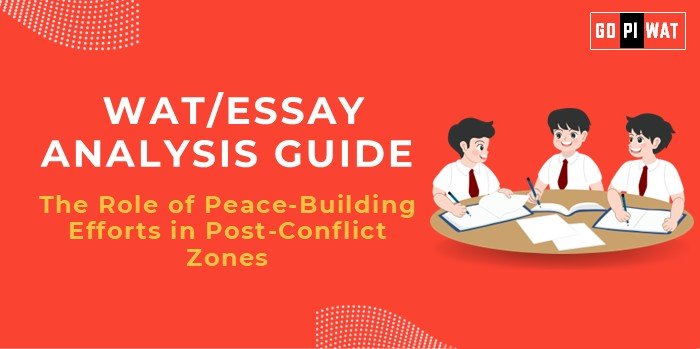📋 Group Discussion Analysis Guide: The Role of Peace-Building Efforts in Post-Conflict Zones
🌐 Introduction to the Topic
📖 Opening Context
Post-conflict zones often suffer from deep-rooted challenges like broken governance, societal mistrust, and infrastructural damage. Peace-building efforts aim to stabilize these areas, fostering reconciliation, development, and long-term peace.
📜 Topic Background
Peace-building, formalized by the UN in the early 1990s, involves diverse strategies such as institutional reform, economic revitalization, and community integration. Examples include post-genocide Rwanda and the Balkans after the Yugoslav Wars.
📊 Quick Facts and Key Statistics
- 📈 Conflict Recurrence Rate: Nearly 60% of civil wars reignite within five years without effective peace-building measures (UNDP, 2023).
- 🌍 Global Refugee Population: Over 35 million displaced people worldwide highlight the urgency of stabilizing conflict zones (UNHCR, 2023).
- 💰 Funding Gap: A $3 billion annual shortfall in global peace-building budgets (World Bank, 2023).
- 📖 Case Study Success: Rwanda’s Gacaca courts resolved over a million genocide-related cases, fostering societal healing (Brookings, 2022).
🤝 Stakeholders and Their Roles
- 🏛️ Governments: Ensure law and order, implement reforms, and provide services.
- 🌐 International Organizations: Facilitate funding, technical expertise, and monitoring (e.g., UNDP, World Bank).
- 📢 Civil Society: Promote grassroots reconciliation and community involvement.
- 🏢 Private Sector: Aid economic revitalization through investments and job creation.
🏆 Achievements and Challenges
✨ Achievements
- 🤝 Reconciliation Models: South Africa’s Truth and Reconciliation Commission became a benchmark for healing racial divides.
- 📈 Economic Recovery: Post-war Vietnam achieved a 7% GDP growth rate for two decades.
- 🌍 Community-Led Initiatives: Colombia’s peace accords reduced armed conflict by 40%.
- 📊 Global Peace Index Trends: 30% of post-conflict states improved on the Global Peace Index between 2015-2022.
⚠️ Challenges
- 🏛️ Fragile Institutions: Corruption and weak governance hinder trust-building.
- 💰 Funding Deficits: Many programs rely on donor aid, creating sustainability concerns.
- 🌏 Cultural Barriers: Mistrust among ethnic or ideological groups impedes cooperation.
🌍 Global Comparisons
- ✅ Success: Rwanda’s community-driven healing processes.
- ⚠️ Failure: Afghanistan’s reliance on external intervention without strong local ownership.
📖 Case Studies
- 🇷🇼 Rwanda’s Community Courts: Enabled rapid justice delivery post-genocide.
- 🇬🇧 Northern Ireland Peace Agreement: Reduced conflict significantly via stakeholder negotiations.
💡 Structured Arguments for Discussion
- 🛠️ Supporting Stance: “Peace-building efforts reduce the likelihood of conflict resurgence by fostering reconciliation, governance, and development.”
- 🛡️ Opposing Stance: “Without sufficient local involvement, peace-building efforts can fail, as seen in Afghanistan’s challenges post-2001.”
- ⚖️ Balanced Perspective: “While peace-building fosters stability, its success depends on addressing root causes of conflict and ensuring inclusivity.”
🎯 Effective Discussion Approaches
🔑 Opening Approaches
- 📊 Use Compelling Data: “60% of civil wars reignite within five years if peace-building fails.”
- 📖 Cite Case Studies: “Rwanda’s reconciliation courts transformed societal trust after the genocide.”
⚙️ Counter-Argument Handling
- 🔄 Challenge: “Peace-building lacks local ownership.”
- ✅ Rebuttal: “Inclusive community involvement, as in Colombia, proves vital for success.”
🧠 Strategic Analysis of Strengths and Weaknesses
SWOT Analysis:
- 💪 Strengths: Promotes reconciliation and societal healing; attracts international investment for reconstruction.
- 🛠️ Weaknesses: Dependent on sustained funding and political will; often disrupted by external influences.
- 🌟 Opportunities: Leveraging technology for governance and education; expanding private-public partnerships.
- ⚠️ Threats: Political instability and lack of trust in institutions; risk of donor fatigue.
🏫 Connecting with B-School Applications
📚 Real-World Applications
- 🌍 Designing sustainable development projects in conflict zones.
- 📖 Case study research on stakeholder roles in peace-building.
🎓 Sample Interview Questions
- ❓ “How can technology enhance peace-building efforts?”
- ❓ “Compare peace-building models in Rwanda and Northern Ireland.”
💡 Insights for Students
- 📈 Analyze stakeholder dynamics in conflict resolution.
- 💼 Explore the economic implications of rebuilding post-conflict zones.


